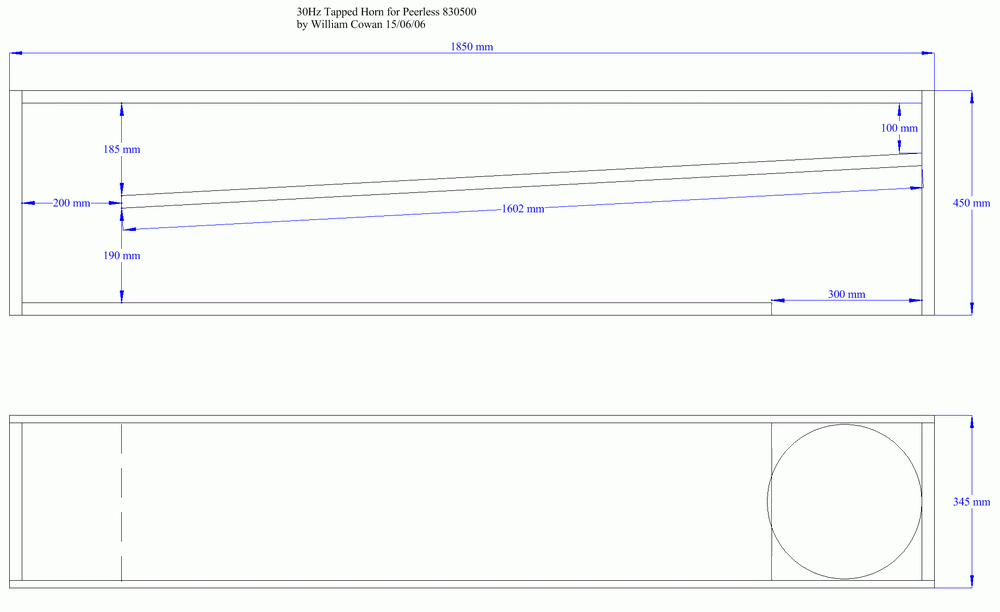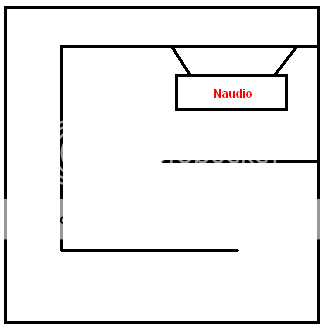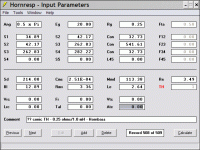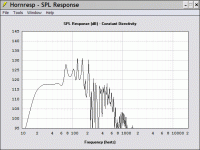I modelled it in google sketchup if that's any help? Basically I made William Cowan's 30Hz TH, but I used sketchup to figure out the different cuts I had to make as I was using 18mm ply instead of 25mm MDFfreddi said:re:Mike Hunt's TH - whats its drawing? - I've had months of vertigo misery and need some bass :^)
hi Mike - (I think William had 2 versions of throat size for the 30hz) whats the partition's gaps distances from the rear wall at the start and at the top where it goes around the bend? did you try near-mouth graphing? did it look like your Eminence driver was running outta xmax in that strenious sweep video? that was a lotta of spl ! (if build -i'll be using ~18mm plywood)
Best, Freddy
Best, Freddy
Hey Freddi,freddi said:hi Mike - (I think William had 2 versions of throat size for the 30hz) whats the partition's gaps distances from the rear wall at the start and at the top where it goes around the bend? did you try near-mouth graphing? did it look like your Eminence driver was running outta xmax in that strenious sweep video? that was a lotta of spl ! (if build -i'll be using ~18mm plywood)
Best, Freddy
I went for William's newer version with a 48mm throat as it gives better response when modeled in Hornresp with my Eminence driver.
More info here:
http://www.cowanaudio.com/th.html
Heres a pic with a few dimensions for 16mm ply (my ply turned out to be 16mm even tho I ordered 18mm).
An externally hosted image should be here but it was not working when we last tested it.
The internal width of the whole thing is 320mm.
CLS said:Well, seeing so many successful and fascinating experiences about this, I can't help playing with the hornresp and the woofer I have on hand.
It seems not so good. Loud and deep, yes. But what the xxxx of those peaks and dips!
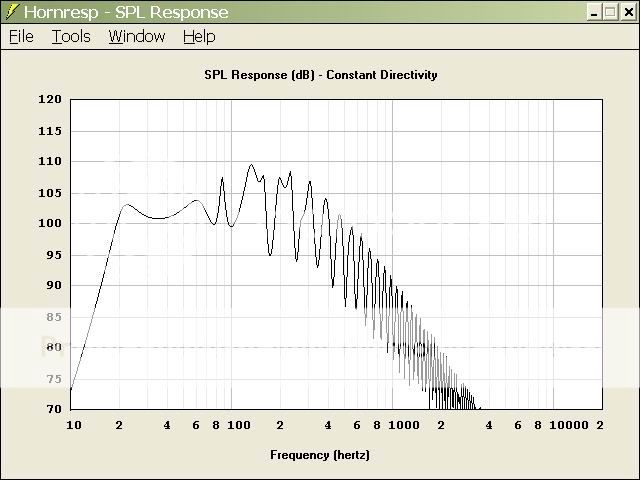
Maybe this can only be used for 80Hz and down with a very very sharp xover....
Can it get any better than this? Or this big dump driver is just a big no go in such application?
This is the data:

The problem is the length of S1. In my experience, the tapped horn simulation in horn response gets weird when any one of the pathlengths approach zero. In your simulation, S1 is barely a fraction of an inch. Modify that to a "sane" value and your simulation won't be so wonky. For instance, with a twelve inch driver your S1 will be in the neighborhood of six inches or more.
OK, I really want to build something. Here is my criteria;
Freq range: 18-60hz, the lower and flatter the better.
Size: < 28 ft^3 ~ 792 l, smaller the better
Driver < $150
In looking through PE catalog there are a number of car subs that might work but not enough specs to plug into HornResp. Are there any other resources that have more complete info about drivers?
In discussing with William Cowan off list, he suggested that I try to find drivers with the following characteristics;
12 - 15" Driver
QTS Between .3 and .6
FS ~ 30 Hz
XMax > 9 mm
The drivers I have found with more complete specs and XMax > 9mm and qts between .3 and .6 tend to have fs in the low 20s.
I want something to replace my Sealed Rythmik Audio DS15 Which can produce Low Freqs, but without as much authority as I would like. My listening room is ~16' x 25' x 9'.
Any Ideas?
Paul
Freq range: 18-60hz, the lower and flatter the better.
Size: < 28 ft^3 ~ 792 l, smaller the better
Driver < $150
In looking through PE catalog there are a number of car subs that might work but not enough specs to plug into HornResp. Are there any other resources that have more complete info about drivers?
In discussing with William Cowan off list, he suggested that I try to find drivers with the following characteristics;
12 - 15" Driver
QTS Between .3 and .6
FS ~ 30 Hz
XMax > 9 mm
The drivers I have found with more complete specs and XMax > 9mm and qts between .3 and .6 tend to have fs in the low 20s.
I want something to replace my Sealed Rythmik Audio DS15 Which can produce Low Freqs, but without as much authority as I would like. My listening room is ~16' x 25' x 9'.
Any Ideas?
Paul
Originally posted by aceinc Are there any other resources that have more complete info about drivers?
You could try http://www.thielesmall.com/database.asp
aceinc said:OK, I really want to build something. Here is my criteria;
Freq range: 18-60hz, the lower and flatter the better.
Size: < 28 ft^3 ~ 792 l, smaller the better
Driver < $150
In looking through PE catalog there are a number of car subs that might work but not enough specs to plug into HornResp. Are there any other resources that have more complete info about drivers?
In discussing with William Cowan off list, he suggested that I try to find drivers with the following characteristics;
12 - 15" Driver
QTS Between .3 and .6
FS ~ 30 Hz
XMax > 9 mm
The drivers I have found with more complete specs and XMax > 9mm and qts between .3 and .6 tend to have fs in the low 20s.
I want something to replace my Sealed Rythmik Audio DS15 Which can produce Low Freqs, but without as much authority as I would like. My listening room is ~16' x 25' x 9'.
Any Ideas?
Paul
The sub you have looks like quality to me. Why don't you just save yourself a lot of trouble and buy one or two more? Additional subs smooth out the in-room response and increase maximum SPL.
Also, take the t/s parameters with a grain of salt; I measure all my drivers and I've never found a single woofer that measured anywhere near it's published specs. Generally the FS is much higher than advertised. I have a TC Sounds 15" which is supposed to have a FS of 18hz and it was at 35hz! That's almost 100% off.
erniesthings said:How would a design like Williams 30hz ... To a design like this one? Are there pros and cons to one design over another?
Thanks, Ernie
I think you're asking for a one-paragraph explanation of horn theory. Sorry, it ain't possible!
All horns are compromises, and the trick is to simulate, then find compromises that don't invalidate the simulation. Tom Danley confessed that he sometimes has to build 2 or 3 versions before he gets it right.
In post #1490, I showed one way to fold a horn. Also, Erik's website, http://www.volvotreter.de has a simple procedure that's not as accurate (but much easier). The Jensen TransFlex was built as a single fold and a three fold. I think Don Bunce used the TransFlex as his model.
This isn't rocket science ... but it isn't tinkertoys either!
Patrick:
It wouldn't be a hobby if we did things completely logically.
Yes the DS15 is a great sub, and with it's little buddies (2 titanic 10's in small sealed cabinets) it does a good job. I could buy another DS15, but what would that do to my carbon footprint?
Isn't it all about being green as you shake the leaves off of your neighbor's trees. Maybe a DS12 or DS15 in a TH?
A number of years ago I built a Decware Wicked One 36" for fun and it rocked the house. I was hoping to get the ultimate in fast loud bass with a TH design. Something that would have excessive amounts of infrasonic and low bass headroom.
Besides wouldn't everyone here be interested in the results?
Paul
It wouldn't be a hobby if we did things completely logically.
Yes the DS15 is a great sub, and with it's little buddies (2 titanic 10's in small sealed cabinets) it does a good job. I could buy another DS15, but what would that do to my carbon footprint?
Isn't it all about being green as you shake the leaves off of your neighbor's trees. Maybe a DS12 or DS15 in a TH?
A number of years ago I built a Decware Wicked One 36" for fun and it rocked the house. I was hoping to get the ultimate in fast loud bass with a TH design. Something that would have excessive amounts of infrasonic and low bass headroom.
Besides wouldn't everyone here be interested in the results?
Paul
erniesthings said:How would a design like Williams 30hz
To a design like this one?
Are there pros and cons to one design over another?
Thanks
Ernie
They would act about the same within certain restrictions. If their length, expansion rate, driver, etc is the same AND if the horn is acoustically small within its passband, then they act the same. Once you go to frequencies, where the wavelength / 4 gets smaller than any internal dimension (wall to wall, difference between inner and outer radius at a corner), its no longer acoustically small and will not entirely act like the hornresp model.
Pros and cons depend on your situation. Williams horn will have an early notch in the frequency response due to the length, at a frequency where wavelength / 2 is = length of the horn (wall to wall). The other one will be difficult to predict, because you dont really know what counts as hornpath, since the foldings are quite a part of the volume.
HORNRESP VERSION 19.20
Hi Everyone,
Just letting you know that the Hornresp Tapped Horn Wizard tool has been further enhanced. Throat and mouth areas can now be adjusted from within the tool. Version 19.20 refers - see the link below for further details.
http://www.diyaudio.com/forums/showthread.php?postid=1525411#post1525411
Kind regards,
David
Hi Everyone,
Just letting you know that the Hornresp Tapped Horn Wizard tool has been further enhanced. Throat and mouth areas can now be adjusted from within the tool. Version 19.20 refers - see the link below for further details.
http://www.diyaudio.com/forums/showthread.php?postid=1525411#post1525411
Kind regards,
David
Thanks David its a great enhancement,
played around with the new Hornresp and Carpower(Monacor) SP-167C a very cheap 6,5"
driver with TSP Data I've found on a forum (not published specs): not exactly loud but loud enough for a flat?
Looks like 49L, 23Hz, crossover possible at 100Hz... for 12¤ + wood
ok, one more 66L 27~150Hz(I need a high crossover frequency for my Satellites):
-Micha
EDIT: This is accidently based on QUARTERSPACE but for free placement it isnt bad
Placed in a corner (black ~1st, grey 2nd):
played around with the new Hornresp and Carpower(Monacor) SP-167C a very cheap 6,5"
driver with TSP Data I've found on a forum (not published specs): not exactly loud but loud enough for a flat?
Looks like 49L, 23Hz, crossover possible at 100Hz... for 12¤ + wood
An externally hosted image should be here but it was not working when we last tested it.
An externally hosted image should be here but it was not working when we last tested it.
ok, one more 66L 27~150Hz(I need a high crossover frequency for my Satellites):
An externally hosted image should be here but it was not working when we last tested it.
-Micha
EDIT: This is accidently based on QUARTERSPACE but for free placement it isnt bad

Placed in a corner (black ~1st, grey 2nd):
An externally hosted image should be here but it was not working when we last tested it.
Ok, thats right,
but I am aiming for a "large" bandwidth... if I set a electrical crossover point around 80Hz (black graph) it will be possible to have a flat acoustic response from 27 to ~140Hz. I guess through multiple folding and low crossover point the peeks will be brought down a bit. (I hope so) Also, I have good experience with the damping material Horst mentioned, will try that on the prototype too.
Did I forget something?
-Micha
but I am aiming for a "large" bandwidth... if I set a electrical crossover point around 80Hz (black graph) it will be possible to have a flat acoustic response from 27 to ~140Hz. I guess through multiple folding and low crossover point the peeks will be brought down a bit. (I hope so) Also, I have good experience with the damping material Horst mentioned, will try that on the prototype too.
Did I forget something?
-Micha
- Home
- Loudspeakers
- Subwoofers
- Collaborative Tapped horn project
